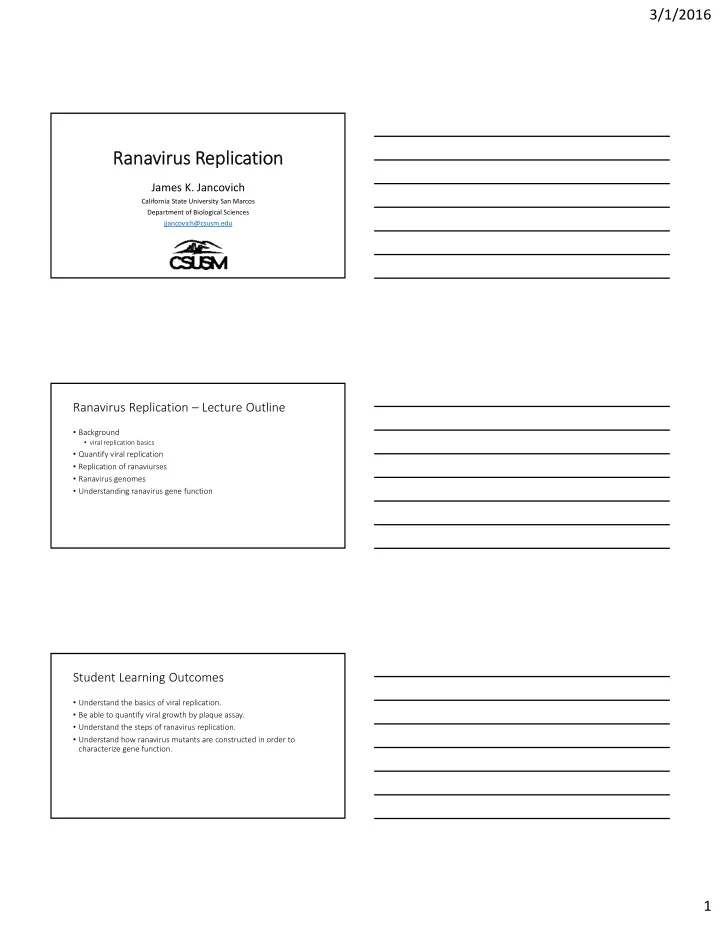

3/1/2016 Rana Ranavirus virus Replic plicatio ion James K. Jancovich California State University San Marcos Department of Biological Sciences jjancovich@csusm.edu Ranavirus Replication – Lecture Outline • Background • viral replication basics • Quantify viral replication • Replication of ranaviurses • Ranavirus genomes • Understanding ranavirus gene function Student Learning Outcomes • Understand the basics of viral replication. • Be able to quantify viral growth by plaque assay. • Understand the steps of ranavirus replication. • Understand how ranavirus mutants are constructed in order to characterize gene function. 1
3/1/2016 Definitions: • A suscep susceptibl ble cell has a functional receptor for a given virus the cell may or may not be able to support viral replication. • A re resistant cell has no receptor – it may or may not be competent to support viral replication. • A permis permissiv sive cell has the capacity to replicate virus; however, it may or may not be susceptible. • A suscep susceptibl ble AND permissi ssive ve cell is the only cell that can take up a virus particle and replicate it cytopathic effects (CPE) 2
3/1/2016 cytopathic effects (CPE) Flint et al ., 2009 How can we determine the number of ranavirus particles in a solution? • Direct count • End ‐ point assay • Plaque assay • PCR assays • Immuno ‐ assays 3
3/1/2016 Plaque Assay mock 10 ‐ 2 10 ‐ 3 10 ‐ 4 10 ‐ 5 10 ‐ 6 100 µl 900 µl of diluent in each tube Sample 10 ‐ 1 10 ‐ 2 10 ‐ 3 10 ‐ 4 10 ‐ 5 10 ‐ 6 Plate 100 µl Plaque Assay # pfu #pfu/ml = x DF plating factor (ml) DF = 1/dilution want between 20 – 200 pfu 4
3/1/2016 Plaque Assay # pfu #pfu/ml = x DF plating factor (ml) DF = 1/dilution plate 100 µl 10 ‐ 5 dilution want between 20 – 200 pfu Flint et al ., 2009 Chen et al., 2011 5
3/1/2016 Multiplicity of Infection (MOI) • Number of virus particles per cell [MOI (pfu/cells) = # pfu/# cells] • Example: • Infect 10 6 cells with 10 7 virions • MOI is 10 • However, not all cells receive 10 virions! MOI • Infection depends on random interaction between virus and cell. • Therefore, some cells are infected with 1, 2, 3 or more virions….while others not infected. • We can explain this by the Poisson distribution 6
3/1/2016 7
3/1/2016 You have a stock of virus with a titer of 6.8 x 10 8 pfu/ml. What volume of this virus you would need to infect 1 x 10 6 cells with the following multiplicity of infection (MOI): (Note: You cannot measure volumes less than 0.5 µl.) A. 0.001 B. 5 Jancovich et al., 2015 Liu et al., 2016 8
3/1/2016 Model entry route of SGIV into GS cells. Shaowen Wang et al. J. Virol. 2014;88:13047-13063 Circularly Permutated, Terminally Redundant Unit length genome: ABCDEFGHIJKLMNOPQRSTUVWXYZ ABCDEFGHIJKLMNOPQRSTUVWXYZABCDEFGHIJKLMNOPQRSTUVWXYZABCDEFGHIJKLMNOPQRSTUVWXYZABCDEFGHIJKL… ABCDEFGHIJKLMNOPQRSTUVWXYZABCDEFGHIJ KLMNOPQRSTUVWXYZABCDEFGHIJKLMNOPQRST UVWXYZABCDEFGHIJKL…. 9
3/1/2016 Strand Displacement http://viralzone.expasy.org/all_by_species/2676.html http://viralzone.expasy.org/all_by_species/1940.html Liu et al., 2016 12 hpi ATV 57R mock wtATV - + - + - + IFN A. B. eIF2 Jancovich et al. , 2011 10
3/1/2016 Liu et al., 2016 Liu et al., 2016 Liu et al., 2016 11
3/1/2016 Liu et al., 2016 Jancovich et al., 2015 Jancovich et al., 2015 12
3/1/2016 How to understand ranavirus gene function? • Ectopic expression • Knock ‐ down • Knock ‐ out • Induced expression Chen et al., 2011 Chen et al., 2011 13
3/1/2016 Chen et al., 2011 A. ORF Viral Genomic DNA [wtRV] Selectable/ Screenable P marker recombination cassette LA RA Selectable/ Screenable P marker Recombinant Virus [RV ORF] Aron et al., 2016 phase contrast fluorescence Aron et al., 2016 14
3/1/2016 ATV ∆ 40L wtATV ATV ∆ 54R ATV ∆ 57R ATV ∆ 25R Aron et al., 2016 Jancovich et al., 2011 Table of Recombinant Ranaviruses Virus ORF Predicted Function Mutant Phenotype Reporter Marker Reference FV3 26R eIF2 α homologue antagonist of PKR; increased EGFP ‐ puromycin Chen et al., 2011 apoptosis; reduced pathogenesis resistance 82R ICP ‐ 18 increased apoptosis; reduced EGFP ‐ puromycin “ pathogenesis resistance 52L β‐ hydroxysteroid tbd; reduced pathogenesis EGFP ‐ puromycin Andino et al., 2015 dehydrogenase homolog resistance 64R caspase activation and IFN s ; increased apoptosis; EGFP ‐ puromycin “ recruitment domain ‐ reduced pathogenesis resistance containing (CARD) protein ATV 57R eIF2 α homologue antagonist of PKZ; ; reduced neomycin resistance Jancovich and pathogenesis Jacobs 2011 11R unknown essential gene GFP ‐ neomycin Aron et al., resistance accepted 25R RNase III degrades RNA GFP ‐ neomycin “ resistance 40L CARD ‐ containing gene tbd; see FV3 above GFP ‐ neomycin “ resistance 53R unknown essential gene GFP ‐ neomycin “ resistance 54R unknown tbd GFP ‐ neomycin “ resistance RGV 53R viral envelope protein green virus EGFP He et al., 2012 92R thymidine kinase (TK) non ‐ essential EGFP “ 53R viral envelope protein required for viral production; IPTG inducible; EGFP He et al., 2013 reduced growth when not expressed 2L viral envelope protein required for viral production; IPTG inducible; EGFP He et al., 2014 reduced growth when not expressed 92R/67R TK and deoxyuridine EGFP/RFP Huang et al., 2016 triphosphatase (dUTPase, DUT) ESV 114L dihydrofolate reductase non ‐ essential EGFP ‐ neomycin Martin et al., 2015 (DHFR) resistance STIV VP55 viral envelope protein green virus EGFP ‐ VP55 fusion Huang et al., 2011 Robert and Jancovich, submitted 15
3/1/2016 Additional Readings • Andino et al., 2015. Characterization of Frog Virus 3 knockout mutants lacking putative virulence genes. Virology , 485: 162 ‐ 170. • Liu et al., 2016. Visualization of Assembly Intermediates and Budding Vacuoles of Singapore Grouper Iridovirus in Grouper Embryonic Cells. Scientific Reports , 6: 18696 16
Recommend
More recommend